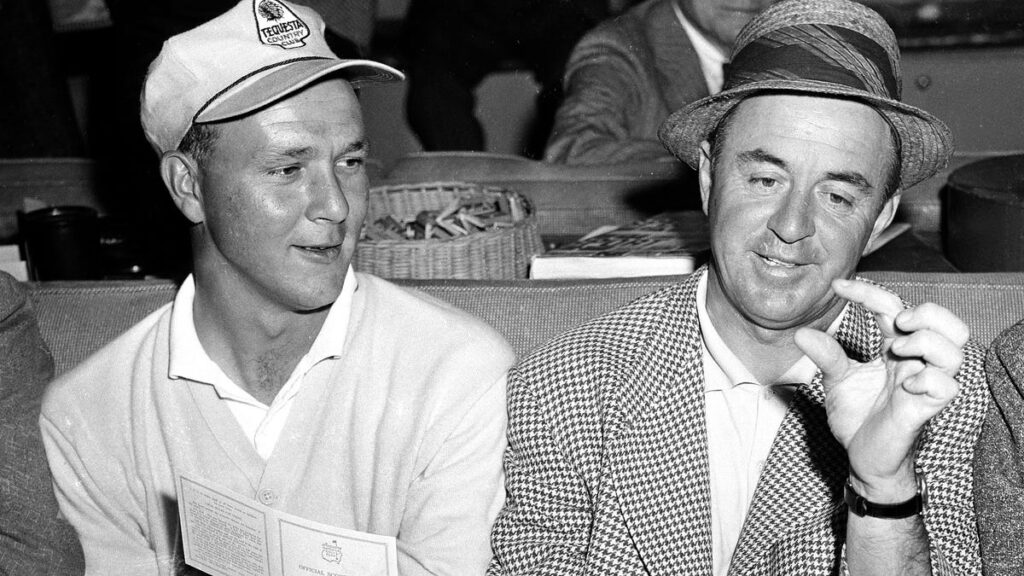Gene Sarazen was a delightful and charming man who was very cooperative when I asked if I could record him, saying, “Sure, why not?”
We went out on the porch on the second floor of the clubhouse one morning early in tournament week at some point during the early eighties.
He always had a smile on his face and spoke with insights and levity, punctuating his conversations with gentle outbursts of laughter. He was very patient, generous with his time and enjoyed reminiscing about his golf career and never tired of recalling his double eagle at No. 15 in 1935, “the shot that was heard around the world.”
This is how he remembered, perhaps, the most famous shot in golf (his playing partner was Walter Hagen).
“Hagen played his drive first because I was a little ahead of him, and then we had quite a debate between the caddie (and me). His name was Stovepipe. He was a minister in town. Stovepipe says, ‘I don’t think you can carry that pond with a four wood. That’s a long shot and you have a close lie. Maybe you better hit a three wood.’ I said, ‘No, I can’t get the ball in the air,'”Sarazen said.
“Hagen yells over, ‘Hurry up, I’ve got a dinner engagement.’ So, I took the four wood and I hit it. And you know, there was no excitement. Everything was absolutely still. And the shot was traveling in the air and the crowd didn’t seem to even see the ball. Then all of a sudden it hit just short of the green, and it trickled up and down into the hole. With that, the 23 people that were sitting around the green jumped to their feet and (started) yelling, and I knew it must have been in the hole because they don’t do that unless the ball does go in the hole. Well, one of those 23 people was Robert T. Jones. So, I had great witnesses—I had Hagen and I had Robert T. Jones as witnesses.”
Byron Nelson
Nelson had the most interesting career with the goal of making enough money from playing golf to buy a ranch in Roanoke, Texas—roughly 17 miles northwest of the DFW Airport.
He was able to achieve his objective, retiring from golf in 1946. Owing to a blood disorder, Nelson was exempt from military service. However, he played golf exhibitions for the sale of war bonds.
After the war, he returned to “Fairway Ranch” (750 acres) and continued his preferred lifestyle. In 1968 the PGA Tour renamed the Dallas tournament for Nelson. The Byron Nelson Classic was a popular tour event for years and Nelson hosted the event until he was physically unable.
That kept him involved with the tour and was financially relevant for him. It kept his streak (winning 18 tournaments, 11 in a row in 1945) constantly in print and prominent in television coverage.
Winner of two Masters titles, he was invited to do some design work on the Par 5, 8th hole and was always heaping praise on Cliff Roberts and Bobby Jones for the first class manner in which they ran the Masters and how much the players appreciated the first major tournament of the year.
When I asked him which of his records meant the most, surprisingly the 11 victories in a row was not his answer.
“The thing I am most proud of was finishing in the money in 113 consecutive tournaments (still a record),” he said. “(That) showed me two or three things about myself. One was that my swing was repeatable, hitting the ball more or less the same all the time. Not having any bad rounds. Most of those tournaments there were only 12 or 15 prizes, not 40 or 50 as it became on the tour later on. I think Jack Nicklaus lost his streak at about 105.”
Arnold Palmer
On Sunday after the leaders started the final round in 1979, the King sat down with me in the Champions locker room for much of an hour to reflect on his time at Augusta. He talked about the thrill of victory (he won four Green Jackets), and the agony of defeat, namely 1961 when he came to the 18th tee needing only a par to win but doubled bogeyed the hole, giving the tournament to a surprised Gary Player.
Included in his thoughts about the golf course, he said this about “Amen Corner;” I think that the corner is probably the most exciting series of golf holes that I have ever played starting at 10,11, 12, 13—they may not be the most difficult holes in golf, but they are certainly the most exciting under tournament conditions when the pressure’s on and the wind is blowing and all the things that can happen are happening—those holes are going to give you the thrill that you really want or might be looking for in golf or in life.
The toughest hole at the Augusta National? “I suppose, even in consideration of the corner, which are certainly very tough holes, I look at the 4th hole as one of the most difficult holes in the world. It is not a hole that you might make a double or triple bogey on, it is a hole (where) you just make a lot of bogeys. Five is also a difficult hole, and I think those two holes if we ever took an average, you’d find more bogeys there than any other holes on the golf course.”
As you likely agree, Masters champions all have a lot to say when they reflect on their time in Augusta.
Read the full article here



